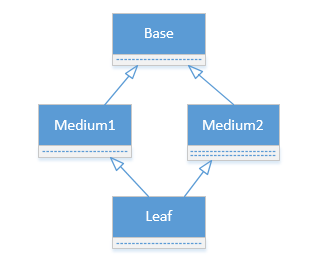1、python的继承以及调用父类成员
python子类调用父类成员有2种方法,分别是普通方法和super方法
假设Base是基类
class Base(object): def __init__(self): print("Base init")
普通方法如下
class Leaf(Base): def __init__(self): Base.__init__(self) print “Leaf init”
super方法如下
class Leaf(Base): def __init__(self): super(Leaf, self).__init__() print “Leaf init”
在上面的简单场景下,两种方法的效果一致
>>> leaf = Leaf()
Base init
Leaf init
2、钻石继承遇到的难题

如果我们还是用普通方法调用父类成员,代码如下
class Base(object): def __init__(self): print “Base init” class Medium1(Base): def __init__(self): Base.__init__(self) print “Medium1 init” class Medium2(Base): def __init__(self): Base.__init__(self) print “Medium2 init” class Leaf(Medium1, Medium2): def __init__(self): Medium1.__init__(self) Medium2.__init__(self) print “Leaf init”
当我们实例化Leaf对象时,结果如下
>>> leaf = Leaf()
Base init
Medium1 init
Base init
Medium2 init
Leaf init
可以看到Base被初始化了两次,这是由于Medium1和Medium2各自调用了Base的初始化函数导致的
3、python的解决方法
python使用的是super来解决这个问题
我们把上面的钻石继承用super重写一下,看一下输出结果
class Base(object): def __init__(self): print “Base init” class Medium1(Base): def __init__(self): super(Medium1, self).__init__() print “Medium1 init” class Medium2(Base): def __init__(self): super(Medium2, self).__init__() print “Medium2 init” class Leaf(Medium1, Medium2): def __init__(self): super(Leaf, self).__init__() print “Leaf init”
我们生成Leaf对象:
>>> leaf = Leaf()
Base init
Medium2 init
Medium1 init
Leaf init
可以看到整个初始化过程符合我们的预期,Base只被初始化了1次。而且重要的是,相比原来的普通写法,super方法并没有写额外的代码,也没有引入额外的概念
4、super的内核:mro
要理解super的原理,就要先了解mro,mro是method resolution order的缩写,表示了类继承体系中的成员解析顺序
在python中,每个类都有一个mro的类方法,我们来看一下钻石继承中,Leaf类的mro是什么样子的
>>> Leaf.mro() [<class '__main__.Leaf'>, <class '__main__.Medium1'>, <class '__main__.Medium2'>, <class '__main__.Base'>, <type 'object'>]
可以看到mro方法返回的是一个祖先类的列表,Leaf的每个祖先都在其中出现一次,这也是super在父类中查找成员的顺序
通过mro,python巧妙的将多继承的图结构,转变为list的顺序结构,super在继承体系中向上的查找过程,变成了在mro中向右的线性查找过程,任何类都只会被处理一次
通过这个方法,python解决了多继承中的2大难题
1、查找顺序问题,从Leaf的mro顺序可以看出,如果Leaf类通过super来访问父类成员,那么Medium1的成员会在Medium2之前被首先访问到,如果Medium1和Medium2都没有找到,最后再到Base中查找
2、钻石继承的多次初始化问题,在mro的list中,Base类只出现了一次,事实上任何类都只会在mro list中出现一次,这就确保了super向上调用的过程中,任何祖先类的方法都只会被执行一次
至于mro的生成算法,可以参考https://en.wikipedia.org/wiki/C3_linearization
5、super的具体用法
我们首先来看一下python中的super文档
>>> help(super) Help on class super in module __builtin__: class super(object) | super(type, obj) -> bound super object; requires isinstance(obj, type) | super(type) -> unbound super object | super(type, type2) -> bound super object; requires issubclass(type2, type)
光从字面来看,这可以算是python中最语焉不详的帮助文档之一了。甚至里面还有一些术语误用。那super究竟应该怎么用呢,我们重点来看super中的第1和第3种用法
5.1super(type,obj)
当我们在Leaf的__init__中写这样的super时:
class Leaf(Medium1, Medium2): def __init__(self): super(Leaf, self).__init__() print “Leaf init”
super(Leaf,self).__init__()的意思是说:
1、获取self所属类的mro,也就是[Leaf, Medium1, Medium2, Base]
2、从mro中Leaf右边的一个类开始,依次寻找__init__函数,这是从Medium1开始寻找
3、一旦找到,就把找到的__init__函数绑定到self对象,并返回
从这个执行流程可以看到,如果我们不想调用Medium1的__init__,而想要调用Medium2的__init__,那么
super应该写成:super(Medium1, self)__init__()
5.2super(type,type2)
当我们在Leaf中写类方法的super时
class Leaf(Medium1, Medium2): def __new__(cls): obj = super(Leaf, cls).__new__(cls) print “Leaf new” return obj
super(Leaf,cls).__new__(cls)的意思是说
1、获取cls这个类的mro,这里也是
2、从mro中Leaf右边的一个类开始,一次寻找__new__函数
3、一旦找到,就返回“”非绑定”的__new__函数
由于返回的是非绑定的函数对象,因此调用时不能省略函数的第一个参数,这也是调用__new__时,需要传入参数cls的原因
同样的,如果我们想从某个mro的某个位置开始查找,只需要修改super的第一个参数就行
6、小结
至此,我们讲解了和super相关的用法及原理,小结一下我们讲过的内容有:
1、python调用父类成员共有2种方法:普通方法,super方法
2、在钻石继承中,普通方法会遇到Base类两次初始化的问题
4、用实例展示了python使用super可以解决此问题
5、讲解了super两种主要的用法及原理
6、Python3.x 和 Python2.x 的一个区别是: Python 3 可以使用直接使用 super().xxx 代替 super(Class, self).xxx :